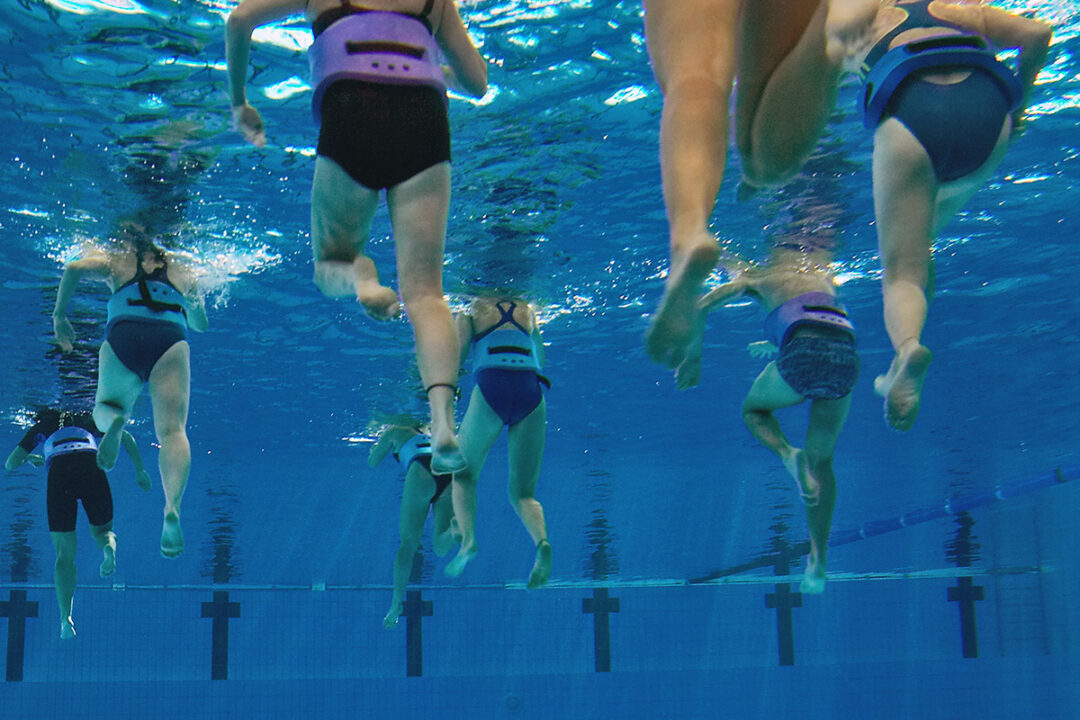Services | Swimming and water exercise | Aquajogging
Aquajogging is literally jogging in deep water. It is a joint-friendly way to improve fitness and strengthen muscles effectively. Aquajogging is suitable for almost everyone, regardless of fitness level and age. A floating, waist-tied water belt is used as an aid. If necessary, you can borrow a belt from our swimming pools, but you can also buy your own from our customer service point, from the sports department of department stores or, for example, at ALTAALLE.com or klubbensport.fi
You can practice aquajogging freely in each of our swimming pools for the price of a swimming visit.

You can practice aquajogging freely in each of our swimming pools for the price of a swimming visit. At Mäkelänrinne, there are usually two aquajogging lanes in use, and in our other halls there is usually at least lane reserved for aquajogging. Depending on the lane reservations and the number of visitors, it is sometimes possible for the lifeguards to open an additional track for aquajogging.
Aquajogging is a very joint-friendly sport because water supports the body and water buoyancy facilitates muscle work. It offers an excellent way of moving in the water for those for whom traditional swimming is not suitable for one reason or another. Aquajogging is particularly suitable for people suffering from joint pain, neck and back pain, overweight and the elderly. The sport is good if a repetitive strain injury strikes and other exercise is banned. It is also suitable for people who are afraid of water, as there is no need to put your head in the water.
In the swimming pool, general etiquette must be followed, i.e. in aquajogging, the rotation takes place according to the direction of travel. In addition, aquajogging should be carried out sequentially, especially during rush hour (Mäkelänrinne), so that the jogging does not disturb passing swimmers or other aquajoggers. In other halls, aquajogging next to each other is allowed, taking other joggers into account.
The aquajogging belt must be of the right kind, as a poorly fitting belt affects the running position and thus technique. When choosing a belt, remember four important things: safety, durability, fit and buoyancy. A properly selected belt holds well on the surface, and the body remains in an upright position. The correct place for the belt is at the waist, not in the armpits. The belt should not be too buoyant and its shape should be suitable for the body so that water does not get between the back and the belt. This way, the aquajogging belt does not start to rise and the running goes smoothly. The belt should also feel comfortable
Fasten the belt to the narrowest part of your waist with the belt’s strap. The logo or text on the back of the float appears behind and the badge is upside down. Snap the lock securely closed. The belt should be tight, but it should not squeeze too much. A belt that is too loose will rise to your armpits.
Your posture should be relatively straight, though leaning forward slightly, by 15–20 degrees, is a good position. If you lean too far forward (your swimming resembles dog paddle), you should slow down and straighten your jogging position more.
Your gaze should be directed straight ahead to a reference point about half a meter above the surface of the water.
Your jogging movements should be rhythmic. The legs extended back with each kick, the ankle also extended at the end. A short leg kick can be corrected when you remember to lift your thigh all the way up.
Your arms and elbows should be at an angle of about 90 degrees. They add rhythm to the jogging by swinging on each side of the body and balancing the movements. Hands scoop water back, fingers together. Lateral movement of the hands should be avoided.
The overall running rhythm is firm and clear. The opposite arm and leg are at the same time in front. Unnecessary fumbling is a typical mistake that can be corrected when you focus on a rhythm that rolls calmly.
You can change the efficiency of the movement by changing the running tempo. The faster the tempo, the more effective the workout. A good training tip is interval training, where the slower and faster tempos vary.
Variation in aquajogging can be obtained, for example, by moving forward with your legs straight skiing or by jogging occasionally with your hands above the surface. This increases the efficiency of your jogging and effects slightly different muscle groups.
TIP: If you want to learn a better aquajogging technique or get some variety in your workout, join our Aquajogging course!